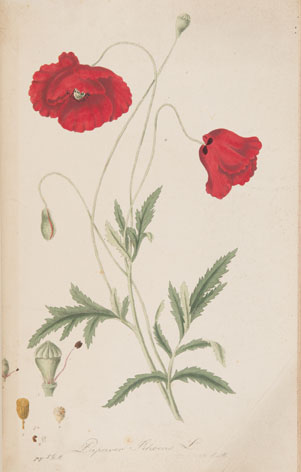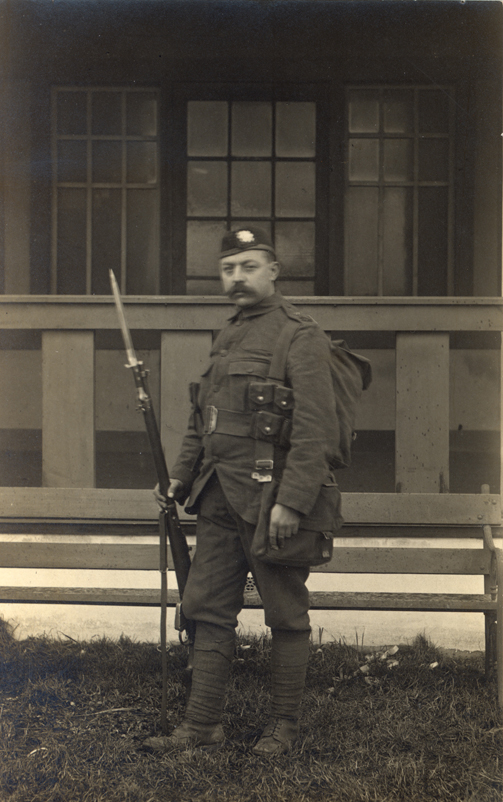Walter Henry Morland joined the Royal Botanic Garden Edinburgh (RBGE) on the 5th January 1910 as a rose specialist. He came to RBGE near the age of 30 as an experienced gardener having worked at a nursery in his home town of Maidstone in Kent, and in gardens in Cambridge and Oxfordshire before joining the Royal Botanic Garden at Kew in April 1905, staying until March 1907. Being on the staff at Kew entitled Morland to membership of the Kew Guild, an association of past and present employees allowing them to keep in touch long after they have moved on elsewhere. On joining RBGE, Morland was not only keeping in contact with his fellow Kewites, but he also initiated our own Guild, becoming its first Secretary. In the first volume of the RBGE Guild Journal Morland is credited with ‘the wholehearted enthusiasm that he devoted … to the hard work connected with [the Guild’s] inauguration and the preparation of the first number of the Journal’.
Morland was working in the RBGE Rock Garden in August 1914 when war was declared. He, along with many of his colleagues joined the 5th Battalion of the Royal Scots, enlisting on the 2nd September 1914 (although Kew’s records contradict this, stating he enlisted on the 31st August). This battalion went on to become part of the 88th Brigade of the 29th Division, sent out to the strategically important Gallipoli peninsula between March and April 1915 when it was decided to have the land army clear the way for the Navy after the Navy failed in their attempt to clear the way for the land army. It was vital for the Allied war effort that the Army and Navy gain control of Gallipoli and the Dardanelles as it was here that entry to the Black Sea was gained – the Germans needed control of this (which they essentially had at the outbreak of hostilities due to a pact with Turkey) to prevent access and supplies reaching the Allied force of Russia, the Allies needed to take control of it to secure this access, open up a third front against Germany and to force Germany’s ally Turkey out of the War.
Morland’s story is told in the Journal of the Kew Guild where it states that after enlisting he trained at Edinburgh until 19th March 1915 when the Regiment left for the Gallipoli peninsula via Egypt. He sent a “cheery” letter to his former colleagues at Kew two days before he left Edinburgh “full of hope and a promise to write his experiences for the Journal”. Tragically, however, Morland was dead within two months.
He survived the ‘Battle of the Beaches’ – the terrible landings on the peninsula on the 25th April, managed through a hail of Turkish bullets tactically withheld until they could do the most damage. The main objective for this first day was to reach and take control of the village of Krithia, around four miles along the peninsula – no progress could be made towards Constantinople without doing this first. However, because the troops quickly became hemmed in on the beaches due to the overpowering Turkish defences, and despite a concerted effort to do so during the ‘First Battle of Krithia’ on the 28th April, very little progress towards Krithia had been made by the start of May. The Turks launched a counter attack at this time, breaking through the first line of Allied trenches in the Gully Ravine (a valley along the northern coast of the peninsula leading towards the north of Krithia) – they were eventually stopped by the fixed bayonets of the 5th Royal Scots – Morland was quite possibly involved in this achievement. One of the Army’s official records states that Morland was killed on the 2nd May. If so, he likely died during this counter attack. However RBGE’s records and an account recorded at Kew Gardens contradict this, giving his date of death as the 7th May 1915 as outlined below.

Papaver rhoeas from Mann, J.G. “Deutschlands wildwachsende Arzney-Pflanzen und deren gewöhnlichste Verwechslungen II“, Stuttgart. (1823-1828)
On the 6th May 1915 the Second Battle of Krithia was launched. The initial artillery bombardment supposed to clear the way for the Allied troops was ineffectual and three days were spent attempting to reach Krithia and the nearby hilltop of Achi Baba. Again it was futile – the biggest gain was 400 yards along the Fir Tree Spur to the south of Gully Ravine. It looks likely that this was where Morland as part of the 88th Brigade was positioned. The action here became known as the ‘Battle of Fir Tree Wood’, the wood itself being held by the Turkish army. At 10am on the 7th May the 5th Royal Scots launched an attack on the men positioned in the wood – they made progress but once inside, the wood became a death trap, full of snipers camouflaged with green paint, leaves and twigs, eventually forcing the Scots to withdraw. (The Allies were destined never to reach Krithia.) The Kew Journal’s description of what happened to Morland fits perfectly with what happened at Fir Tree Wood. Apparently he “did not return from a desperate assault on a wood below Krithia on May 7. For three weeks no traces of him could be found and it was supposed he had been taken prisoner; then his chums, during an advance found his body.” Morland has no known grave though, and is remembered at Gallipoli on the Helles Memorial.
.
He was the first former member of Kew staff to fall during the First World War, and RBGE’s second (although unlike Kew we did not record casualties amongst our former members of staff), and as such is remembered on War Memorials at both Gardens.
Thanks are due to Garry Ketchen and to Mark Norris of Newquay Zoo for providing genealogical research about Morland.
.
Some of Mark Norris’s Newquay Zoo’s War Gardener Blogs which mention Morland:
RBGE commemorates WW1
Lost gardeners of Kew
.
Morland’s obituary in the Journal of the Kew Guild can be found here: Morland’s obituary

